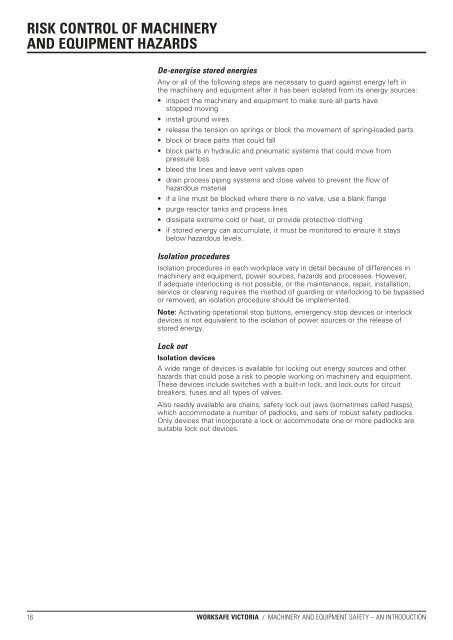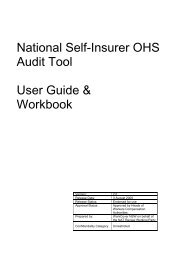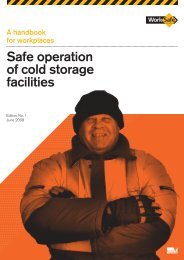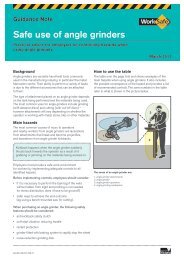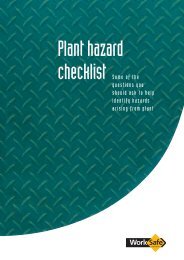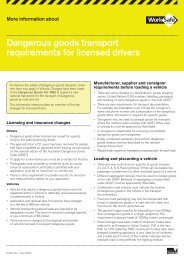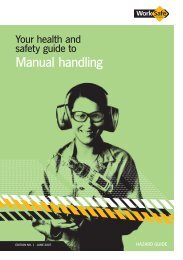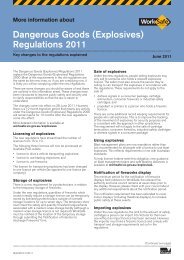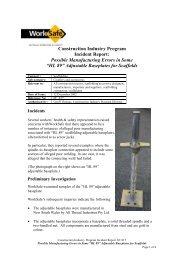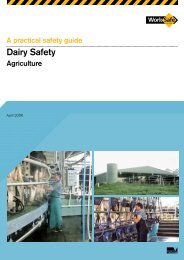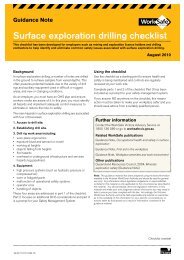Machinery and Equipment Safety - An Introduction - WorkSafe Victoria
Machinery and Equipment Safety - An Introduction - WorkSafe Victoria
Machinery and Equipment Safety - An Introduction - WorkSafe Victoria
You also want an ePaper? Increase the reach of your titles
YUMPU automatically turns print PDFs into web optimized ePapers that Google loves.
RISK CONTROL OF MACHINERY<br />
AND EQUIPMENT HAZARDS<br />
De-energise stored energies<br />
<strong>An</strong>y or all of the following steps are necessary to guard against energy left in<br />
the machinery <strong>and</strong> equipment after it has been isolated from its energy sources:<br />
• inspect the machinery <strong>and</strong> equipment to make sure all parts have<br />
stopped moving<br />
• install ground wires<br />
• release the tension on springs or block the movement of spring-loaded parts<br />
• block or brace parts that could fall<br />
• block parts in hydraulic <strong>and</strong> pneumatic systems that could move from<br />
pressure loss<br />
• bleed the lines <strong>and</strong> leave vent valves open<br />
• drain process piping systems <strong>and</strong> close valves to prevent the flow of<br />
hazardous material<br />
• if a line must be blocked where there is no valve, use a blank flange<br />
• purge reactor tanks <strong>and</strong> process lines<br />
• dissipate extreme cold or heat, or provide protective clothing<br />
• if stored energy can accumulate, it must be monitored to ensure it stays<br />
below hazardous levels.<br />
Isolation procedures<br />
Isolation procedures in each workplace vary in detail because of differences in<br />
machinery <strong>and</strong> equipment, power sources, hazards <strong>and</strong> processes. However,<br />
if adequate interlocking is not possible, or the maintenance, repair, installation,<br />
service or cleaning requires the method of guarding or interlocking to be bypassed<br />
or removed, an isolation procedure should be implemented.<br />
Note: Activating operational stop buttons, emergency stop devices or interlock<br />
devices is not equivalent to the isolation of power sources or the release of<br />
stored energy.<br />
Lock out<br />
Isolation devices<br />
A wide range of devices is available for locking out energy sources <strong>and</strong> other<br />
hazards that could pose a risk to people working on machinery <strong>and</strong> equipment.<br />
These devices include switches with a built-in lock, <strong>and</strong> lock outs for circuit<br />
breakers, fuses <strong>and</strong> all types of valves.<br />
Also readily available are chains, safety lock out jaws (sometimes called hasps),<br />
which accommodate a number of padlocks, <strong>and</strong> sets of robust safety padlocks.<br />
Only devices that incorporate a lock or accommodate one or more padlocks are<br />
suitable lock out devices.<br />
16 WORKSAFE VICTORIA / MACHINERY AND EQUIPMENT SAFETY – AN INTRODUCTION


